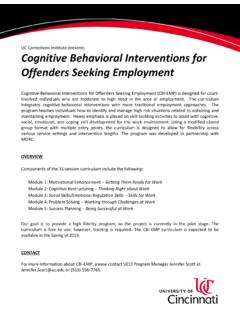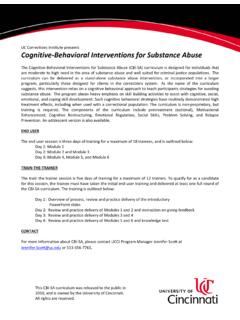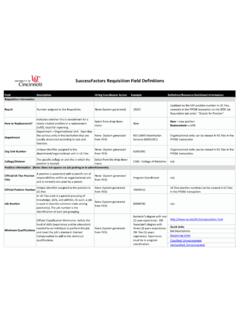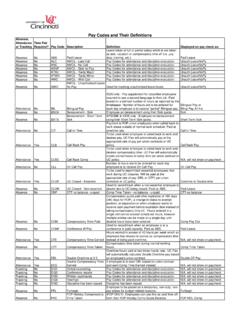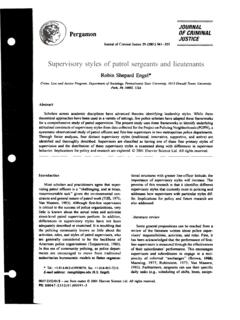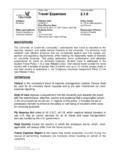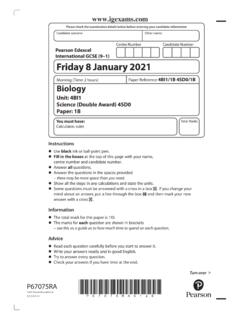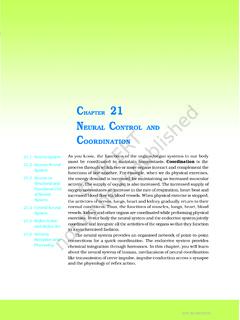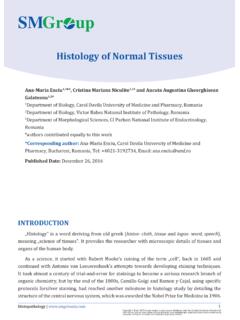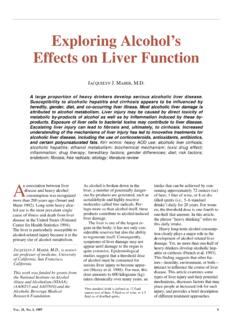Transcription of THE URINARY SYSTEM - University of Cincinnati
1 THE URINARY SYSTEMT housands of metabolic processes in myriad body cells produce hundreds of waste products. The URINARY SYSTEM removes them by filtering and cleansing the blood as it passes through the kidneys. Another vital function is the regulation of the volume, acidity, salinity, concentration, and chemical composition of blood , lymph, and other body fluids. Under hormonal control, the kidneys continually monitor what they release into the urine to maintain a healthy chemical balance. Disorders of the SYSTEM can be subtle, so urination-related symptoms should be promptly URINARY SYSTEM is composed of a pair of kidneys, a pair of ureters, a bladder, and a urethra.
2 These components together carry out the URINARY SYSTEM s function of regulating the volume and composition of body fluids, removing waste products from the blood , and expelling the waste and excess water from the body in the form of two kidneys are reddish organs resembling beans in shape that are situated on either side of the abdomen just above the waist and towards the back of the body. The kidneys contain microscopic filtering units that remove waste, unwanted minerals, and excess water from the blood as urine. Each kidney is connected to the bladder by a long tube called a ureter, which transports urine away.
3 The bladder is a hollow, muscular organ situated centrally in the pelvis; it stores urine until it is convenient to release it. At a certain volume, stretch receptors in its wall transmit nervous impulses that initiate a conscious desire to urinate. The urethra then conducts urine from the bladder to the KIDNEYSThe kidneys sit at the back of the abdominal wall and at the start of the URINARY SYSTEM . These organs are constantly at work: Nephrons, tiny structures in the renal pyramids, filter gallons of blood each day. The kidneys reabsorb vital substances, remove unwanted ones, and return the filtered blood back to the body.
4 As if they weren t busy enough, the kidneys also create urine to remove all the cross sectionThis cutaway shows the kidney s main layers, the cortex and the medulla, which form segments known as renal pyramids. The renal artery and vein circulate huge amounts of blood about 2 1/2 pints/min at rest, which is up to one-quarter of the heart s total kidneys are located behind the peritoneum, and so are called retroperitoneal organs. They sit in the back of the abdomen between the levels of the T12 and L03 vertebrae. The right kidney is slightly lower than the left kidney to accommodate the liver.
5 Both kidneys are bean-shaped and about the size of an adult enters the kidneys through renal arteries. These arteries branch into tiny capillaries that interact with URINARY structures inside the kidneys (namely the nephrons). Here the blood is filtered. Waste is removed and vital substances are reabsorbed back into the bloodstream. The filtered blood leaves through the renal veins. All the blood in the body moves in and out of the kidneys hundreds of times each day that s about 200 quarts of liquid to be filtered every 24 kidney contains over 1 million tiny structures called nephrons.
6 The nephrons are located partly in the cortex and partly inside the renal pyramids, where the nephron tubules make up most of the pyramid mass. Nephrons perform the primary function of the kidneys: regulating the concentration of water and other substances in the filter the blood , reabsorb what the body needs, and excrete the rest as kidneys filter unwanted substances from the blood and produce urine to excrete them. There are 3 main steps of urine formation: Glomerular filtration, ReabsorptionSecretion. These processes ensure that only waste and excess water are removed from the nephron has a glomerulus, the site of blood filtration.
7 The glomerulus is a network of capillaries surrounded by a cuplike structure , the glomerular capsule (or Bowman s capsule).As blood flows through the glomerulus, blood pressure pushes water and solutes from the capillaries into the capsule through a filtration glomerular filtration begins the urine formation nephrons of the kidneys process blood and create urine through a process of filtration, reabsorption, and secretion. Urine is about 95% water and 5% waste products. Nitrogenous wastes excreted in urine include urea, creatinine, ammonia, and uric acid.
8 Ions such as sodium, potassium, hydrogen, and calcium are also produced in the kidneys travels down the ureters into the URINARY bladder. The bladder expands like an elastic sac to hold more urine. As it reaches capacity, the process of micturition, or urination, muscle movements send signals to the nervous SYSTEM , putting the decision to urinate under conscious internal urethral sphincter and the external urethral sphincter both provide muscle control for the flow of urine. The internal sphincter is involuntary. It surrounds the opening of the bladder to the urethra and relaxes to allow urine to pass.
9 The external sphincter is surrounds the urethra outside the bladder and must be relaxed for urination to muscle stretch initiates the micturition reflex by activating stretch receptors in the bladder wall. This autonomic reflex causes the detrusor muscle to contract and the internal urethral sphincter muscle to relax, allowing urine to flow into the urethra. The stretch receptors also send a message to the thalamus and the cerebral cortex, giving voluntary control over the external urethral sphincter. We usually gain this control of urination between the ages of 2 and 3, as our brains PRINTING AND OTHER NEW TECHNOLOGIES TO HELP PATIENTSIn a first for the Middle East, UAE doctors have used 3D printing technology to help safely remove a cancerous tumor from a 42-year-old woman s team of doctors in Dubai have successfully removed a kidney tumor with the help of a transparent, patient-specific 3D printed surgical aid.
10 Not only did the 3D printed aid help them to carefully plan their surgical process for removing the tumor from the patient, but it allowed them to shave an hour off the total operation 3D print was created based off of the patient s CT scans and ultrasounds, and was 3D printed from transparent and colored plastics so that the doctors could visualize where the tumor was located. Since the technology has not yet been integrated in UAE hospitals, the 3D print was ordered from the receiving the 3D printed kidney model, the team of doctors, led by Dr YaserAl Saeedi, was able to properly map out its surgical process to make the actual procedure as minimally invasive as possible.


